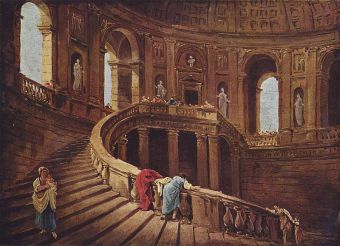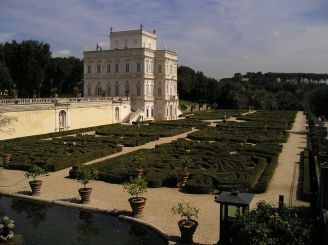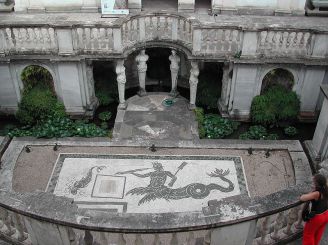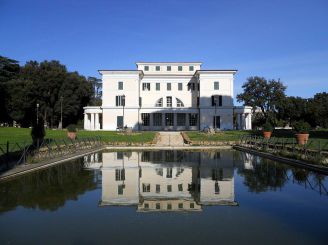Villa Farnese, Caprarola

The Villa Farnese in Caprarola is a massive five-sided Renaissance construction, also known as Villa Caprarola, which was commissioned by Cardinal Alessandro Farnese who later took on Pope’s title under the name of Paul III. Don’t confuse it with Farnese Palace or Villa Farnesina. Proudly towering over the surrounding area, the mansion strikes with its sharp shapes and large sizes. Originally it was intended to be not just a villa, but a fortification of some sort. Those who like Renaissance architecture will find this building since it is considered to be one of the greatest construction projects of the epoch.
History of Villa Farnese
Construction works on the mansion began in 1520, that’s when the foundation designed by architects Antonio da Sangallo the Younger and Baldassare Peruzzi was laid. Its strong five-cornered structure, so-called «rocca», was meant to become a perfect bastion for fending off enemy attacks both from outside and inside.
The building of the villa was stopped in 1549 when Pope Paul III, the commissioner, passed away. Only after ten years, it was resumed by Paul’s III nephew who was named after his grandfather – Cardinal Alessandro Farnese. Great architect and Roman Mannerism genius, Giacomo Barozzi, directed the creation of this architectural masterpiece which was completed around 1573. He managed to turn a potent fortress into a palace whose simple shapes would nicely blend in with surrounding scenery.
Before Cardinal passed away in 1589, he already had a decent collection of sculptural artworks. However after his death relatives that got the inheritance decided that villa’s maintenance was too expensive for them and took all the valuables to Naples. After that, its condition slowly worsened. Currently, the villa is owned by the state.
Architecture, interiors and the gardens
The main entrance has ramps and stairs leading to it from each side. The whole area including the gardens is divided into terraces. A round courtyard surrounded by two levels of porticos can be found in the center of the stark building. This lends the place an interesting contrast and is believed to be some kind of novelty since back in Renaissance times architects preferred rectangular shape. The territory around the palace has a regular and symmetrical layout.
Villa park demonstrates its initial idea - to create a fortification: they have drawbridges and moats filled with water. Two façade corners face two gardens. The lower garden boasts fountains and a boxwood topiary. Once there was also a theater. Moreover, you can find the Casino which is located a little further – it is a famous summerhouse and a miniature replica of the villa. Today it is considered to be one of President’s residences.
The palace includes a ground floor, Piano dei Prelati floor and two level mezzanine floor with 12 state rooms. Each one of them strikes the visitors with frescos that were made by brothers Taddeo and Federico Zuccari and share the same style with the villa – Mannerism. They illustrate feats done by Heracles, the mythic hero of antiquity; Alexander’s the Great deeds, history of the Farnese family and brilliantly so. Famous artists of that time, such as Rafaellino da Regio, Antonio Tempesta, Giacomo del Duca, Giovanni de'Vecchi worked on frescos as well.
How to get
The Villa Farnese is located in Caprarola town, Lazio region, 50 km north-west of Rome. You can also find Lake Bracciano, a perfect place for leisure activities situated just a bit south from there. The fastest and most convenient way to reach the villa is by bus. Cotral buses regularly travel from Roma Saxa Rubra stop which is in Rome to Caprarola. The trip usually takes around an hour. If a car is your choice of transportation, then drive along SR2bis and SR2, then take a turn to SP35 and follow roadsigns.
Opening hours: from 8:30 till 19:30. The villa is open daily, except for Mondays, January 1 and December 25. The ticket office closes at 18:45. The park is open from March 15 to October 31, from Tuesday till Saturday. Guided tours are run every hour from 10:00 till 16:00 and from April 15 to October 15 – till 17:00.
Admission: full-price ticket costs 5 euros, cut-price one – 2,5 euros. The admission is free during the first Sunday of the month.





